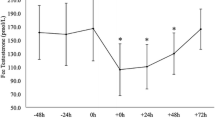Summary
This investigation provides an insight into the physiological changes produced, and processes operating, during and after a typical interval exercise training regime. The role of interval exercise in the modulation of the plasma concentration of sex hormone binding globulin (SHBG) and the hormones β-oestradiol, testosterone, prolactin and growth hormone was assessed. Eight trained male athletes [mean maximal oxygen uptake (\(\dot V\)O2max 64.3 (SD 3.8) ml·kg−1·min−1, mean age 31.5 (SD 4.5) years] undertook an intense interval exercise (treadmill running) protocol to exhaustion. Subjects completed an average of 15.6×1-min runs. This interval protocol produced significant increase in the plasma concentration of SHBG and all four hormones (all P<0.01) in the immediate post-test period. The plasma concentration of the hormones increased as indicated: β-oestradiol (45%), testosterone (38%), prolactin (230%), growth hormone (2000%). These hormones have an established capacity to interact with components of many physiological systems and, as such, may provide a mechanism for the changes induced by intense exercise in many of these systems.
Similar content being viewed by others
References
Aldercreutz H, Harkonen M, Kuoppasalmi K, Kosunen K, Naveri H, Rehunen S (1976) Physical activity and hormones. Adv Cardiol 18:144–157
Anderson DC (1974) Sex hormone binding globulin. Clin Endocrinol 3:69–96
Ben-Jonathan N (1985) Dopamine: a PRL inhibiting hormone. Endocr Rev 6:564–589
Brisson GR, Ledoux M, Peronnet F, Dulac S, Decarufel D, Volle MA, Rainvillet J, Audet A (1981) Prolactinemia in exercising male athletes. Horm Res 15:218–223
Brisson GR, Peronnet F, Ledoux M, Pellerin-Massicotte J, Matton P, Garceau F, Boisvert P (1986) Temperature-induced hyperprolactinemia during exercise. Horm Metab Res 18:283–284
Brown WJ, McGinley R, Vining RF, White S (1980) The effect of endurance exercise on the serum concentrations of estradiol and testosterone in trained and untrained men and women. Proc Aust Physiol Pharmacol Soc 11:131
Bunt JC, Boileau RA, Bahr JM, Nelson RA (1986) Sex and training differences in human growth hormone levels during prolonged exercise. J Appl Physiol 61:1796–1801
Elias AN, Wilson AF, Pandian MR, Chune G, Utsumi A, Kayaleh R, Stone SC (1991) Corticotropin releasing hormone and gonadotropin secretion in physically active males after acute exercise. Eur J Appl Physiol 62:171–174
Farrell PA, Garthwaite TL, Gustafson AB (1983) Plasma adrenocortical and cortisol responses to submaximal and exhaustive exercise. J Appl Physiol 55:1441–1444
Gala RD (1991) Prolactin and growth hormone in the regulation of the immune system. Proc Soc Exp Biol Med 198:513–527
Galbo H (1983) Hormonal and metabolic adaptations to exercise. Thieme, New York
Galbo H, Hummer L, Petersen IB, Christensen NJ, Bie N (1977) Thyroid and testicular hormone responses to graded and prolonged exercise in man. Eur J Appl Physiol 36:101–106
Ganong WIT (1983) Review of medical physiology (11th edn.). Lange, Los Altos, pp 330, 336–369
Godsland IF, Wynn V, Crook D, Miller NE (1987) Sex, plasma lipoproteins and atherosclerosis: prevailing assumptions and outstanding questions. Am Heart J 114:1467–1503
Grossmann CJ (1984) Regulation of the immune system by sex steroids. Endocr Rev 5:435–455
Hahn AG, Pang PM, Tumilty DMcA, Telford RD (1988) General and specific aerobic power of elite marathon kayakers and canoeists. Excel 5:14–19
Jansson G (1991) Oestrogen-induced enhancement of myeloperoxidase activity in human polymorphonuclear leukocytes — a possible cause of oxidative stress in inflammatory cells. Free Radic Res Comm 14:195–208
Jurkowski JE, Jones NL, Walker WC, Younglai EV, Sutton JR (1978) Ovarian hormone responses to exercise. J Appl Physiol 44:109–114
Karagiorgos A, Garcia J, Brooks GA (1979) Growth hormone response to continuous and intermittent exercise. Med Sci Sports 11:302–307
Kelley KW (1989) Growth hormone, lymphocytes and macrophages. Biochem Pharmacol 38:705–713
Keizer HA, Poortmans JR, Bunnik GS (1980) Influence of physical exercise on sex-hormone metabolism. J Appl Physiol 48:109–114
Kindermann W, Schnabel A, Schmidt WM, Biro G, Cassens J, Weber F (1982) Catecholamine, growth hormone cortisol, insulin and sex hormones in anaerobic and aerobic exercise. Eur J Appl Physiol 49:389–399
Kuoppasalmi K, Naveri H, Harkonen M, Aldercreutz A (1980) Plasma cortisol, androstenedione, testosterone, and luteinizing hormone in running exercise of different intensities. Scand J Clin Invest 40:403–409
Lassare C, Girard F, Durand J, Raynaud J (1974) Kinetics of human growth hormone during submaximal exercise. J Appl Physiol 37:826–830
Shephard RJ, Sidney KH (1975) Effects of physical exercise on plasma growth hormone and cortisol levels in human subjects. In: Willmore JH, Keogh JF (eds) Exercise and sport science reviews. Academic Press, New York, pp 1–30
Sowers JR, Raj RR, Hershman JM, Carlson HE, McCalleum RW (1977) The effect of stressful diagnostic studies and surgery on anterior pituitary hormone release in man. Acta Endocrinol 86:25–32
Sutton JR, Coleman MJ, Casey J, Lazarus L (1973) Androgen responses during physical exercise. BMJ:520–522
Sutton JR, Coleman MJ, Casey JH (1976a) Testosterone production rate during exercise. International Congress of Physical Activity Science (abstract) Quebec, p: 72. Cited in: {au{fnJurkowski} {gnJE}}, {au{fnJones} {gnNL}}, {au{fnWalker} {gnWC}}, {au{fnYounglai} {gnEV}}, {au{fnSutton} {gnJR}} ({dy1978}) {atOvarian hormonal responses to exercise}. {jtJ Appl Physiol} {vn44}:{pp109-114}
Sutton JR, Jones NL, Toews CJ (1976b) Growth hormone secretion in acid-base alterations at rest and during exercise. Clin Sci Mol Med 50:241–247
Telford RD (1991) Endurance training. In: Pyke ITS (ed) Better coaching: advanced coaches manual. Australian Coaching Council, Canberra, pp 125–134
Van Beaumont W (1972) Evaluation of haemoconcentration from haematocrit measurements. J Appl Physiol 32:712–713
Viru A (1985) Hormones in muscular activity. CRC Press, Boca Raton
Wilkerson JE, Horvath SM, Gutin B (1980) Plasma testosterone during treadmill exercise. J Appl Physiol 49:249–253
Author information
Authors and Affiliations
Rights and permissions
About this article
Cite this article
Gray, A.B., Telford, R.D. & Weidemann, M.J. Endocrine response to intense interval exercise. Europ. J. Appl. Physiol. 66, 366–371 (1993). https://doi.org/10.1007/BF00237784
Accepted:
Issue Date:
DOI: https://doi.org/10.1007/BF00237784




